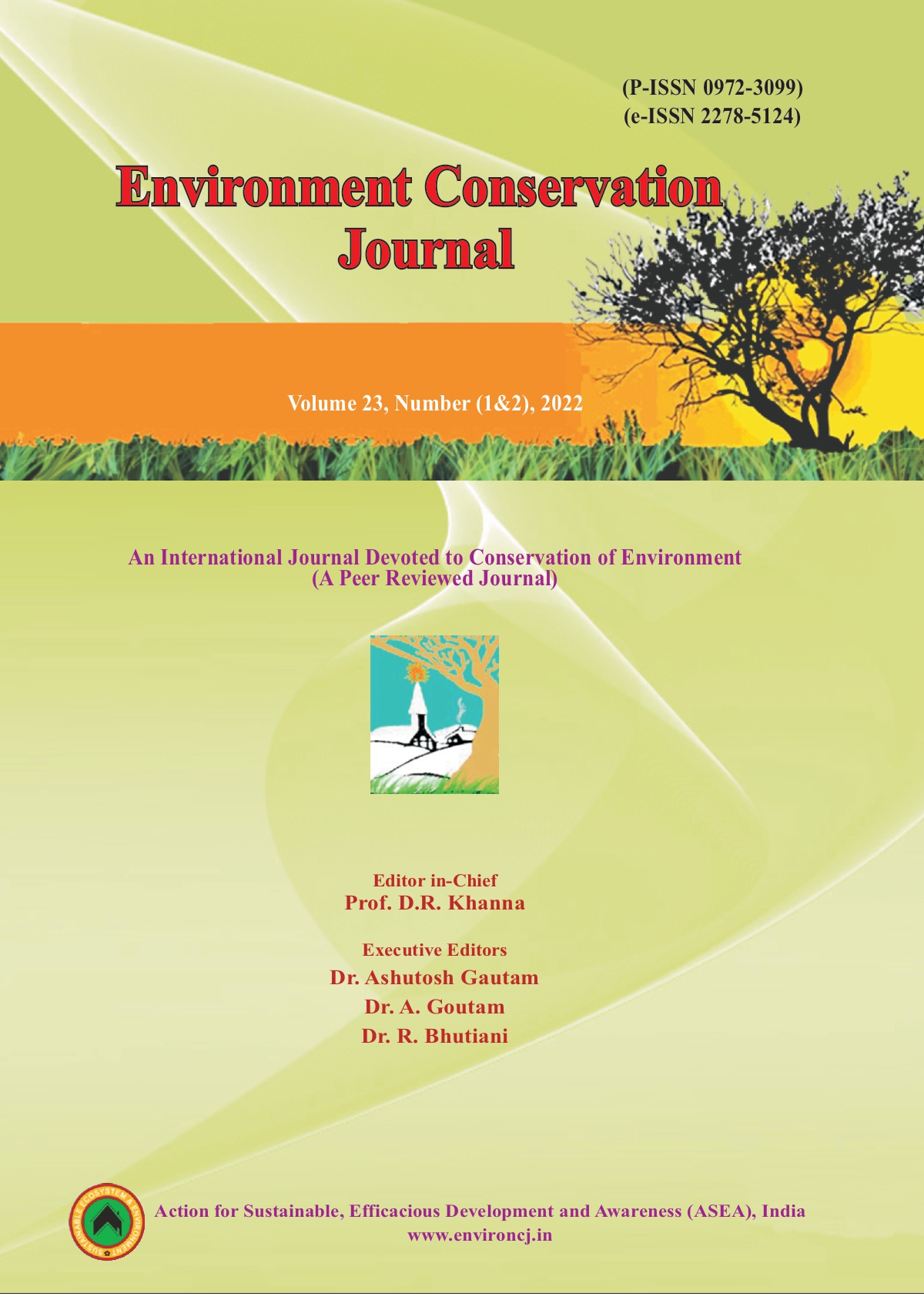Main Article Content
Abstract
A total of 2378 geometrid moth specimens were collected from four districts of Kashmir valley during 2018-2019, which comprised of 39 species belonging to 29 genera, 17 tribes and 4 subfamilies. Five species (Abraxas cashmiria sp. nov., Antipercnia pseudoalbinigrata sp. nov., Aspitates pseudogilvaria sp. nov., Chorodna Baramulia sp. nov. and Xenoplia kashmirensis sp. nov.) are reported for the first time from this area. Diversity indices was highest in Baramulla (H´ = 1.452760) lowest in Srinagar (H´=1.273559). Alcis repandata (Linnaeus) was found to be most dominant species (11.02%), while as Callipia vicinaria (Dognin) was found least dominant (0.25%).
Keywords
Article Details
Copyright (c) 2022 Environment Conservation Journal

This work is licensed under a Creative Commons Attribution-NonCommercial 4.0 International License.
References
- Axmacher, J., & Konrad, F. (2008). Habitat type modifies geometry of elevational diversity gradients in geometrid moths (Lepidoptera; Geometridae) on Mt. Kilimanjaro, Tanzania. Tropical Zoology, 21, 243-251.
- deWaard, J. R., Hebert, P. D., & Humble, L. M. (2011). A comprehensive DNA barcode library for the looper moths (Lepidoptera: Geometridae) of British Columbia, Canada. PloS one, 6(3), e18290. DOI: https://doi.org/10.1371/journal.pone.0018290
- Khan, H., & Perveen, F. (2015). Distribution of Butterflies (Family Nymphalidae) in Union Council Koaz Bahram Dheri, Khyber Pakhtunkhwa, Pakistan. Social and basic sciences research review, 3(1), 52-57.
- Kirti, J. S., Chandra, K., Saxena, A., & Singh, N. (2019). Geometrid Moths of India . Nature Books India.
- Kirti, J. S., Kaur, M., & Goyal, T. (2008). Studies on genitalic structures of six commonly known Geometrid species (Lepidoptera) from Himachal Pradesh. Journal of Entomological Research, 32(2), 161-169.
- Kitching, R., Orr, A., Thalib, L., Mitchell, H., Hopkins, M. S., & Graham, A. W. (2001). Moth assemblages as indicators of environmental quality of Australian rain forest. Journal of Applied Ecology, 37, 284 - 297. DOI: https://doi.org/10.1046/j.1365-2664.2000.00490.x
- Kumar, M., Kumar, P., & Kumar, A. (2018). Taxonomic Study on Geometrid Moths (Lepidoptera: Geometridae) Diversity in Chirpine Forest of Himachal Pradesh. Asian Journal of Advances Basic Science, 6(1), 49-53.
- Pielou, E. S. (1966). The measurement of diversity indifferent of biological collections. Journal of Theoretical Biology, 13, 131-144. DOI: https://doi.org/10.1016/0022-5193(66)90013-0
- Pitkin, L. M., Han, H., & James, S. (2007). Moths of the tribe Pseudoterpnini (Geometridae: Geometrinae): a DOI: https://doi.org/10.1111/j.1096-3642.2007.00287.x
- review of the genera. Zoological Journal of the Linnean Society, 150, 343-412.
- Sajjad, A., Ali, M., Saeed, S., Bashir, M. A., Ali, I., Khan, K.A., Ghramh, H. A., & Ansari, M. J. (2019). Yearlong association of insect pollinator, Pseudapis oxybeloides with flowering plants: Planted forest vs. agricultural landscape. Saudi journal of. Biological sciences, 26(7), 1799–1803. DOI: https://doi.org/10.1016/j.sjbs.2018.02.019
- Shannon, C. E., & Wiener, W. (1963). The Mathematical theory of communication. University of Illinoise Press, Urbana, pp. 127.
- Southwood, T. R. E. (1978). Ecological methods. 2nd Ed. New York: Chapman and Hall, pp. 524. DOI: https://doi.org/10.1007/978-94-015-7291-0
- Van Nieukerken, E. J., Kaila, L., Kitching, I. J., Kristensen, N. P., Lees, D. C., Minet. J., & Zwick, A. (2011). Order Lepidoptera Linnaeus, 1758. In: Zhang Z. Q (Eds). Animal biodiversity: An outline of higher-level classification and survey of taxonomic richness. Zootaxa, 3148, 212–221. DOI: https://doi.org/10.11646/zootaxa.3148.1.39
- Walia, V. K. (2005). Insecta: Lepidoptera: Geometridae (Moths). Zoological Survey of India, Fauna West Himaliyas, 2, 181-190.
References
Axmacher, J., & Konrad, F. (2008). Habitat type modifies geometry of elevational diversity gradients in geometrid moths (Lepidoptera; Geometridae) on Mt. Kilimanjaro, Tanzania. Tropical Zoology, 21, 243-251.
deWaard, J. R., Hebert, P. D., & Humble, L. M. (2011). A comprehensive DNA barcode library for the looper moths (Lepidoptera: Geometridae) of British Columbia, Canada. PloS one, 6(3), e18290. DOI: https://doi.org/10.1371/journal.pone.0018290
Khan, H., & Perveen, F. (2015). Distribution of Butterflies (Family Nymphalidae) in Union Council Koaz Bahram Dheri, Khyber Pakhtunkhwa, Pakistan. Social and basic sciences research review, 3(1), 52-57.
Kirti, J. S., Chandra, K., Saxena, A., & Singh, N. (2019). Geometrid Moths of India . Nature Books India.
Kirti, J. S., Kaur, M., & Goyal, T. (2008). Studies on genitalic structures of six commonly known Geometrid species (Lepidoptera) from Himachal Pradesh. Journal of Entomological Research, 32(2), 161-169.
Kitching, R., Orr, A., Thalib, L., Mitchell, H., Hopkins, M. S., & Graham, A. W. (2001). Moth assemblages as indicators of environmental quality of Australian rain forest. Journal of Applied Ecology, 37, 284 - 297. DOI: https://doi.org/10.1046/j.1365-2664.2000.00490.x
Kumar, M., Kumar, P., & Kumar, A. (2018). Taxonomic Study on Geometrid Moths (Lepidoptera: Geometridae) Diversity in Chirpine Forest of Himachal Pradesh. Asian Journal of Advances Basic Science, 6(1), 49-53.
Pielou, E. S. (1966). The measurement of diversity indifferent of biological collections. Journal of Theoretical Biology, 13, 131-144. DOI: https://doi.org/10.1016/0022-5193(66)90013-0
Pitkin, L. M., Han, H., & James, S. (2007). Moths of the tribe Pseudoterpnini (Geometridae: Geometrinae): a DOI: https://doi.org/10.1111/j.1096-3642.2007.00287.x
review of the genera. Zoological Journal of the Linnean Society, 150, 343-412.
Sajjad, A., Ali, M., Saeed, S., Bashir, M. A., Ali, I., Khan, K.A., Ghramh, H. A., & Ansari, M. J. (2019). Yearlong association of insect pollinator, Pseudapis oxybeloides with flowering plants: Planted forest vs. agricultural landscape. Saudi journal of. Biological sciences, 26(7), 1799–1803. DOI: https://doi.org/10.1016/j.sjbs.2018.02.019
Shannon, C. E., & Wiener, W. (1963). The Mathematical theory of communication. University of Illinoise Press, Urbana, pp. 127.
Southwood, T. R. E. (1978). Ecological methods. 2nd Ed. New York: Chapman and Hall, pp. 524. DOI: https://doi.org/10.1007/978-94-015-7291-0
Van Nieukerken, E. J., Kaila, L., Kitching, I. J., Kristensen, N. P., Lees, D. C., Minet. J., & Zwick, A. (2011). Order Lepidoptera Linnaeus, 1758. In: Zhang Z. Q (Eds). Animal biodiversity: An outline of higher-level classification and survey of taxonomic richness. Zootaxa, 3148, 212–221. DOI: https://doi.org/10.11646/zootaxa.3148.1.39
Walia, V. K. (2005). Insecta: Lepidoptera: Geometridae (Moths). Zoological Survey of India, Fauna West Himaliyas, 2, 181-190.





